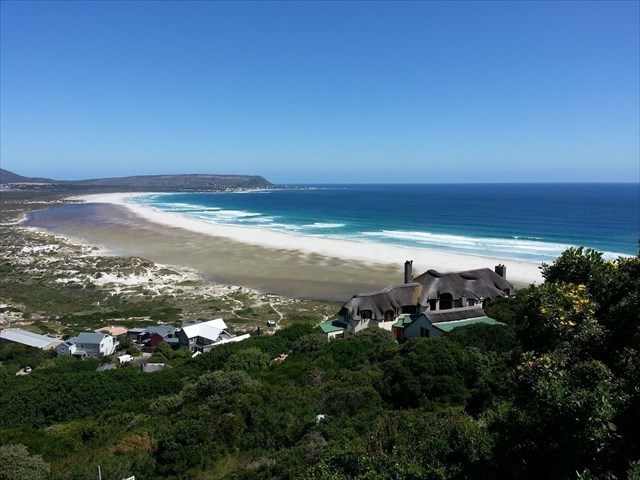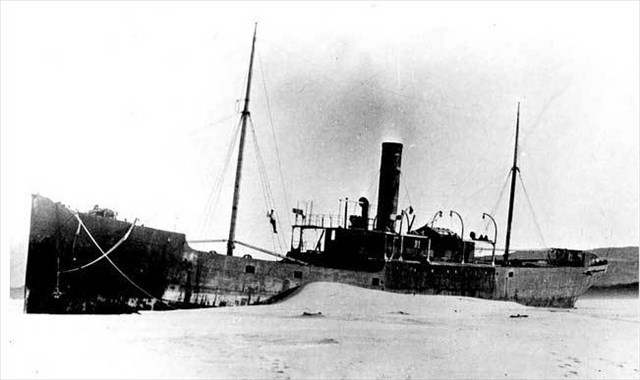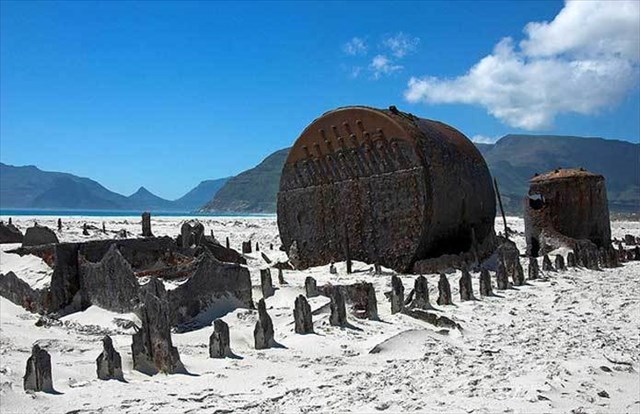Overview
A walk along a quiet stretch of beach to the wreck of the SS Kakapo, a steamer of 1093 tons, stranded on 25th May 1900. The beach is popular with Dog Walkers, Horse Riders and Surfers.

Long Beach, Noordhoek
Caution:
This is a remote stretch of beach - for safety & security it is recommended that this cache is done as part of a group, that you consider leaving valuables at home and remain aware of your surroundings at all times. A four legged friend may also act as a deterrent (don’t tell anybody that Thunder is just a big softie!). As Long Beach falls within the boundaries of Table Mountain National Park, an Activity Permit is required for Dogs and Horse Riding.
The Stranding
Built in 1898 by Grangemouth Dockyard Co., Scotland, the SS Kakapo (named after a green Parrot, indigenous to New Zealand) was on her maiden voyage from Swansea to Sydney, in ballast, being delivered to her new owners, The Union Steamship Company, New Zealand. The ship was under the command of Captain Niels Peter Nicolayson (Danish), and had a crew of 20. Captain Nicolayson had only recently gained his Masters ticket and this was most likely his first command.
After calling at Cape Town to take on coal, Kakapo set sail once more on the afternoon of 25th May 1900. As she headed South towards Cape Point a North-Westerly gale began to build in ferocity. With low cloud and driving rain visibility soon dropped to almost zero.
Before the days of GPS and radar, seamen would have relied on charts, dead-reckoning and visible landmarks. In 1900, the only lighthouse south of Cape Town was the “old” lighthouse (see GC7B71M Cape Light), this had the problem of being high up, and often hidden by mist or fog. It was only replaced by the "new" Cape Point Lighthouse in 1919 - lower down and more visible in bad weather. The Slangkop Lighthouse, south of Kommetjie, was also built in 1919 following the wrecking of "Clan Monroe".
With rough seas, and an onshore wind, Capt. Nicolayson would have been looking for the Cape Point lighthouse, hoping to round Cape Point to the relative shelter of False Bay before darkness fell.
Catching a glimpse of Chapman’s Peak, and mistaking it for Cape Point, Capt. Nicolayson ordered the helm swung hard to port, and at full speed of 9.5 knots, SS Kakapo headed for the beach.
The breaking waves may have been spotted at the last minute, but it was far too late, and Kakapo was driven hard up the beach.
Finding themselves well and truly aground, the lights of a nearby farm were spotted and 2 of the crew sent to get help.
As day broke the next day, the rest of the crew were able to come ashore, hardly getting their feet wet. There were no casualties.

Surrounded by sand
In the following weeks, efforts were made to pull SS Kakapo off the beach but to no avail.
Court of Inquiry
The official report stated: "We are of opinion that the vessel was not navigated with proper or seamanlike care after 4 p.m., and that the captain was not justified in keeping his vessel at full speed in spite of thick and stormy weather, and the erratic behaviour of the compass, and in not using the lead, and that the stranding of the "Kakapo" was due to his act or default. We do therefore adjudge that the certificate of the master, Niels Peter Fischer Nicolaysen, be suspended for a period of three months."
Capt. Nicolayson, a broken man, spent the next 3 years living on the ship before being persuaded to leave. The Union Steam Ship Company never did receive their new ship.

Smoke rises from the smokestack. Capt. Nicolayson in the rigging?
The Kakapo Wreck
The wreck can be approached from either the Noordhoek or Kommetjie sides of the beach. From the North, the walk is about 35-40 min. Approaching from the South is a shorter walk, but may involve wading across the stream that drains the wetlands if there has been recent rain.
Today, the wreck has been reduced to the keel, lower hull, stem and rudder. The outline can be made out from the ribs poking up from the sand. The dominant feature is the "Scotch" Marine Boiler that can be seen from afar. Some of the hull plates were salvaged after World War One and used to reinforce the sea defences along the railway at Clovelly.

The Wreck
The sand around the wreck shifts with the seasons and from year to year exposing varying amounts of the wreck. At times the wreck can be 50m or more from the shoreline. At the present time (Aug 2018) the sea reaches the rudder at high tide.
In Film:
The Kakapo wreck was used as one of the settings in the Oscar winning 1970 film “Ryan’s Daughter” starring Robert Mitchum, Trevor Howard and John Mills. It is interesting to see the wreck as it was almost half a century ago.
To claim this Virtual Cache you will need to visit the wreck and answer the following questions:
1. Describe the wreck - what features can you identify?
2. The boiler tubes are gone - how many would there have been for the outer fireboxes?
3. What spare part can be found approx 7-8m aft of the boiler?
4. The wreck featured in the 1970 film "Ryan's Daughter" - who played the title role?
5. Take a photo of your GPS and/or take a selfie at the wreck. Send your answers and photo to the CO.
Virtual Reward - 2017/2018
This Virtual Cache is part of a limited release of Virtuals created between August 24, 2017 and August 24, 2018. Only 4,000 cache owners were given the opportunity to hide a Virtual Cache. Learn more about Virtual Rewards on the Geocaching Blog.